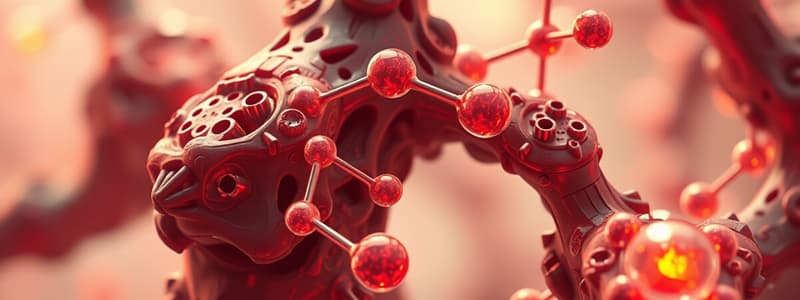Podcast
Questions and Answers
What do 'R groups' in organic chemistry represent?
What do 'R groups' in organic chemistry represent?
- Only carbon atoms in hydrocarbons
- The entire molecular structure
- Specific atoms in a molecule
- Generic regions of a molecule (correct)
Which functional group has a carbonyl carbon bonded to two other carbon atoms?
Which functional group has a carbonyl carbon bonded to two other carbon atoms?
- Ketone (correct)
- Carboxylic Acid
- Alcohol
- Aldehyde
Which functional group is characterized by single bonds between carbon and hydrogen?
Which functional group is characterized by single bonds between carbon and hydrogen?
- Alkane (correct)
- Aldehyde
- Alkyne
- Alkene
Which of the following is an example of an alkane?
Which of the following is an example of an alkane?
What distinguishes an aldehyde from a ketone?
What distinguishes an aldehyde from a ketone?
What distinguishes alkenes from alkanes?
What distinguishes alkenes from alkanes?
Which of the following is a property of carboxylic acids?
Which of the following is a property of carboxylic acids?
What is the eponymous member of the carboxylic acid derivatives?
What is the eponymous member of the carboxylic acid derivatives?
What is an example of a simple alkane?
What is an example of a simple alkane?
What is the bond structure of formaldehyde?
What is the bond structure of formaldehyde?
Which term describes hydrocarbons with carbon-carbon triple bonds?
Which term describes hydrocarbons with carbon-carbon triple bonds?
Which functional group is characterized by a carbonyl carbon bonded to a hydroxyl group?
Which functional group is characterized by a carbonyl carbon bonded to a hydroxyl group?
How do chemists utilize the 'R' notation when drawing organic structures?
How do chemists utilize the 'R' notation when drawing organic structures?
In organic chemistry, what generally refers to atoms like oxygen, nitrogen, or sulfur?
In organic chemistry, what generally refers to atoms like oxygen, nitrogen, or sulfur?
What type of bonds are characteristic of alkenes?
What type of bonds are characteristic of alkenes?
Which of the following statements is true regarding a tertiary alcohol?
Which of the following statements is true regarding a tertiary alcohol?
Which of the following statements is true regarding aromatic groups?
Which of the following statements is true regarding aromatic groups?
What is the classification of chloroform in terms of its chemical structure?
What is the classification of chloroform in terms of its chemical structure?
In alcohol classification, what defines a primary alcohol?
In alcohol classification, what defines a primary alcohol?
Which of the following compounds is a simple alkyl halide commonly used in organic synthesis?
Which of the following compounds is a simple alkyl halide commonly used in organic synthesis?
What is the characteristic functional group present in alcohols?
What is the characteristic functional group present in alcohols?
Which compound was used as a refrigerant until concerns about its effect on the ozone layer arose?
Which compound was used as a refrigerant until concerns about its effect on the ozone layer arose?
What term is used to refer to an alcohol when the hydroxyl group is attached directly to an aromatic ring?
What term is used to refer to an alcohol when the hydroxyl group is attached directly to an aromatic ring?
Which of the following statements about the structure of alkyl halides is false?
Which of the following statements about the structure of alkyl halides is false?
What defines an amide in terms of its chemical structure?
What defines an amide in terms of its chemical structure?
Which of the following statements about esters is true?
Which of the following statements about esters is true?
How are acid anhydrides characterized in their structure?
How are acid anhydrides characterized in their structure?
In which structure is the carbonyl carbon bonded to a phosphate?
In which structure is the carbonyl carbon bonded to a phosphate?
What differentiates a thioester from an ester?
What differentiates a thioester from an ester?
What does the abbreviation 'P' in biological organic chemistry represent?
What does the abbreviation 'P' in biological organic chemistry represent?
Which two sugars mentioned contain different functional groups?
Which two sugars mentioned contain different functional groups?
What common characteristic do glucose and fructose share?
What common characteristic do glucose and fructose share?
What type of molecule is referred to as a 'polyol'?
What type of molecule is referred to as a 'polyol'?
In the provided illustration, what functional groups are depicted in glucose and fructose?
In the provided illustration, what functional groups are depicted in glucose and fructose?
Which of the following statements about phosphates is false?
Which of the following statements about phosphates is false?
Which of the following compounds is not mentioned as containing functional groups?
Which of the following compounds is not mentioned as containing functional groups?
What is the structural feature of molecules described as having multiple functional groups?
What is the structural feature of molecules described as having multiple functional groups?
Flashcards are hidden until you start studying
Study Notes
Drawing Abbreviated Organic Structures
- The letter 'R' is used to represent portions of a molecule outside the focus, allowing for simplified drawings.
- Common examples of 'R groups' include functional groups like primary alcohols and aldehydes.
Common Functional Groups
- Functional groups are crucial in organic chemistry and can significantly influence the properties and reactions of molecules.
- Common functional groups are often categorized and summarized in reference tables.
Hydrocarbons
- Alkanes are the simplest functional group with single carbon-carbon bonds; examples include methane (CH4) and octane (C8H18).
- Alkenes contain carbon-carbon double bonds, while alkynes have triple bonds.
- Aromatic compounds like benzene and naphthalene feature stable planar ring structures and play an important role in various applications.
Alkanes
- General formula: CnH2n+2.
- Methane is a significant component of natural gas, and octane is a critical component of gasoline.
Aromatic Compounds
- Examples include benzene, known for its aromaticity, and naphthalene, recognizable by its distinct smell.
Functional Groups with Carbon-Single Bonds
- Alkyl halides (haloalkanes) emerge when carbon atoms bond with halogens (F, Cl, Br, I), often abbreviated as 'X.'
- Chloroform (trichloromethane) has historical significance in anesthesia and as a laboratory solvent.
- Examples of alkyl halides include chlorodifluoromethane, phased out for environmental concerns, and bromoethane frequently used in organic synthesis.
Alcohols and Thiols
- Alcohols feature a carbon bonded to an OH (hydroxyl) group and can be classified as primary, secondary, or tertiary.
- Primary alcohols bond to one other carbon, while secondary and tertiary alcohols bond to two and three carbons, respectively.
- When directly attached to an aromatic ring, the compound is termed a phenol.
Carbonyl Containing Functional Groups
- Aldehydes (carbonyl with a hydrogen and a carbon) and ketones (carbonyl bonded to two carbons) are characterized by the carbonyl (C=O) functional group.
- Formaldehyde is a simple example of an aldehyde with two hydrogen bonds to its carbonyl carbon.
Carboxylic Acids and Acid Derivatives
- Carboxylic acids are formed when a carbonyl carbon bonds to a hydroxyl (OH) group. Their acidic nature allows them to readily lose protons.
- Amides contain a carbonyl carbon bonded to a nitrogen, while esters have a carbonyl bonded to an oxygen linked to another carbon.
- Acid anhydrides consist of two carbonyls connected by an oxygen, formed from dehydration of two carboxylic acids.
Phosphates
- Phosphates are common in biologically relevant molecules, depicted with the abbreviation 'P' and include various oxygens and charges.
- Acyl phosphates link organic structures to phosphate groups, critical in biochemical processes.
Molecules with Multiple Functional Groups
- Compounds like glucose and fructose demonstrate the presence of multiple functional groups; glucose has both aldehyde and alcohol groups, whereas fructose features a ketone group and multiple alcohols, classifying it as a polyol.
Studying That Suits You
Use AI to generate personalized quizzes and flashcards to suit your learning preferences.




